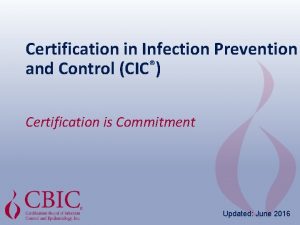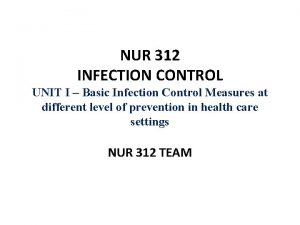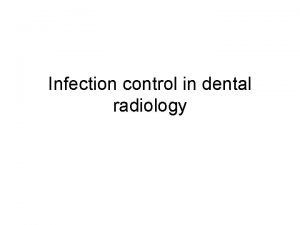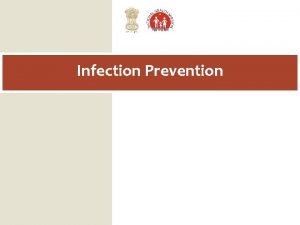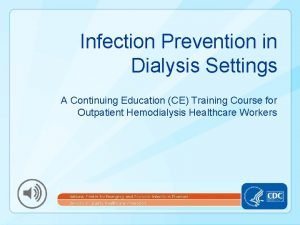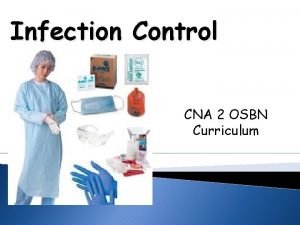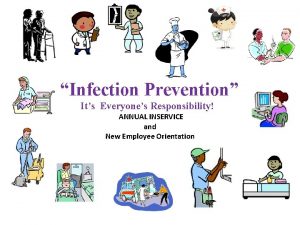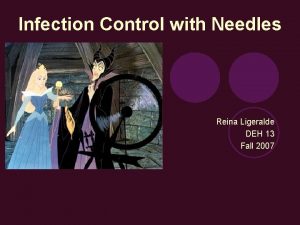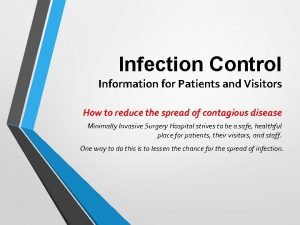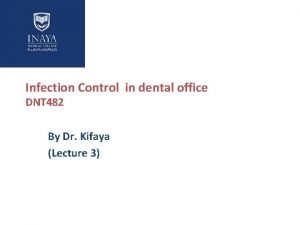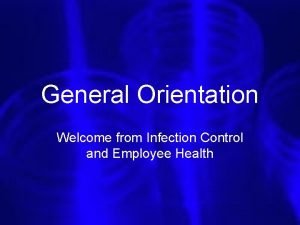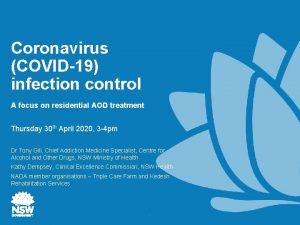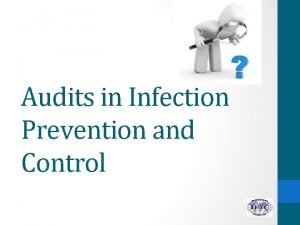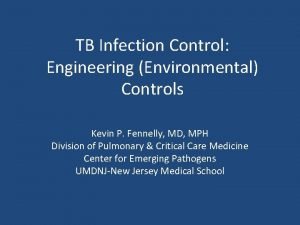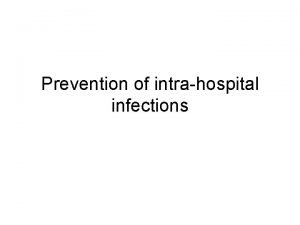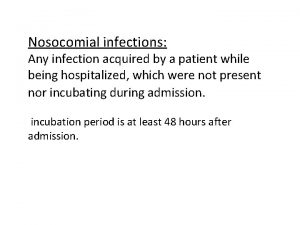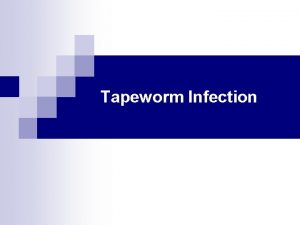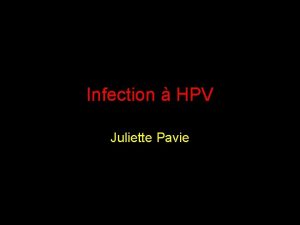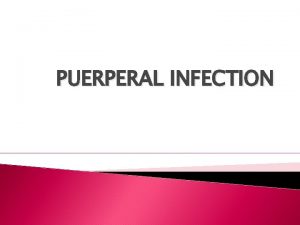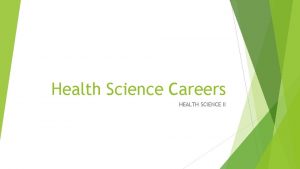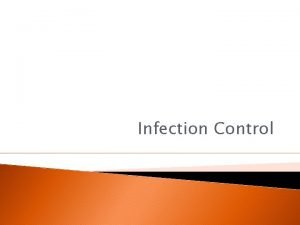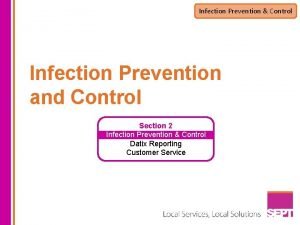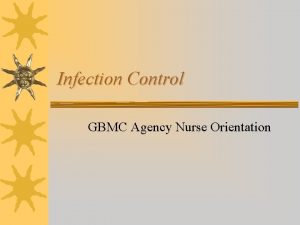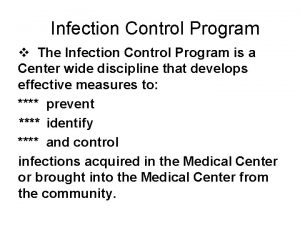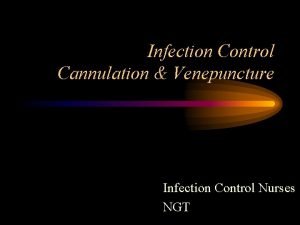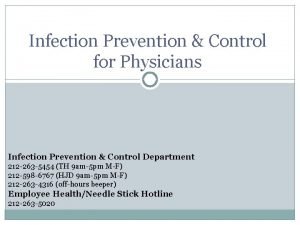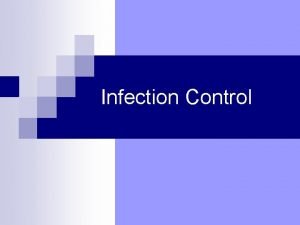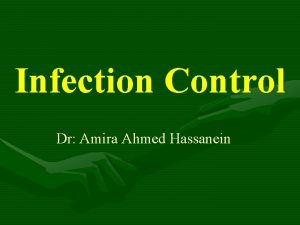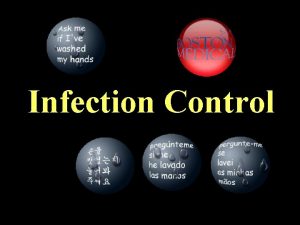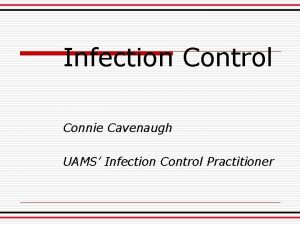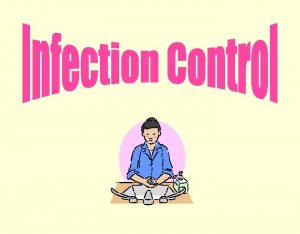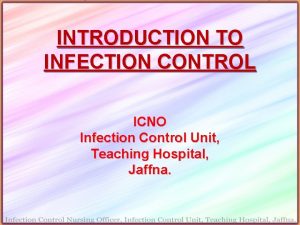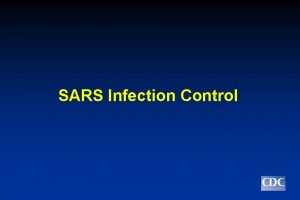Infection Control Advanced Health Science Infection Control n

























- Slides: 25

Infection Control Advanced Health Science

Infection Control n The presence of microorganisms does not automatically mean that an infection will result. n Infection only results if pathogens increase in number and alter the functioning of normal tissues.

Infection Control n After invading the tissue, pathogens compete for space and nutrients. n After gaining control, pathogens continue to replicate and get stronger. n Some infections can spread to other people and are described as being contagious.

Breaking the Chain of Infection n An important way to break the chain of infection is to use aseptic techniques while providing health care. n Asepsis is defined as the absence of disease-producing microorganisms or pathogens. n Aseptic techniques are directed toward maintaining cleanliness and preventing contamination.

Asepsis n Medical asepsis Called “clean technique”. n Includes hand washing, personal protective barriers, and routine cleaning of the environment. n n Surgical asepsis Called “sterile technique”. n Only sterile objects can come in contact with sterile objects. Otherwise, they must be considered contaminated. n

Methods That Destroy Microorganisms n Cleaning – cleaning removes soil, food, or other matter from a surface. n Examples – soap and water. n Antiseptics – solutions applied directly to the skin that prevent or inhibit the growth of pathogens. n Examples – Betadine, Alcohol.

Methods That Destroy Microorganisms n Disinfection – using strong chemicals, such as bleach to destroy pathogens, usually on objects, not skin. n Examples – Bleach solutions, Zephirin. n Sterilization – the most effective way to destroy all microorganisms. n Steam under pressure, gas, radiation, and chemicals can be used. (Autoclave)

Methods That Destroy Microorganisms n FYI: skin and hair cannot be sterilized because any solutions or procedures that kill microorganisms are harmful to skin/scalp.

Handwashing n. A basic task required in any health occupation. n Handwashing is the most important method used to practice aseptic technique and the most effective way to prevent the spread of infection.

Handwashing n Wash your hands frequently! n When you arrive at the facility and immediately before leaving the facility. n Before and after every patient contact. n Any time hands become contaminated during a procedure. n Before and after any contact with your mouth or mucous membranes. n n n Before applying and after removing gloves. Before and after handling specimens. After contact with soiled or contaminated items. After picking up any item off the floor. After personal use of the bathroom. After you cough, sneeze, or use a tissue.

Handwashing n Use soap – aids in the removal of germs through its sudsy action and alkali content. Pathogens are trapped in the soapsuds and rinsed away. n Use liquid soap (bars can contain microbes). n n Use warm water – creates a better lather with soap, less damaging to the skin than hot water.

Handwashing Friction – helps rub off pathogens from the surface of the skin. n All surfaces on the hands must be cleaned. n n Palms, backs/tops, areas between fingers. Fingertips must be pointed downward so water doesn’t get on forearms and then run back down to contaminate the hands. n Dry paper towels should be used to turn the faucet on and off. n Fingernails – keep short, clean underneath. n

Managing a Personal Exposure Incident n An occupational exposure incident can be defined as a Percutaneous injury – needlestick or cut with a sharp object. n Contact of mucous membrane or nonintact skin with blood, saliva, tissue, or other body fluids that are potentially infectious. n n Exposure incidents place health care workers at risk for infections.

Managing a Personal Exposure Incident Personal exposure incidents should be immediately reported to your supervisor, according to OSHA standards. Complete the designated incident reporting forms. n All exposure incidents should be treated as a medical emergency and tended to immediately. n n Wounds and skin sites should be washed with soap and water. Mucous membranes should be flushed with water. Follow all instructions for immediate medical evaluation and follow-up care.

Standard Precautions ALL blood and body fluids are considered contaminated. n ALL patients must be considered potential sources of infection. n Guidelines established by OSHA (1991). n n Hand washing is vital. Personal protective equipment is necessary. Equipment and procedures depend upon the disease and how it is spread.

Standard Precautions n Wash hands before and after contact with any patient. n Personal protective equipment n n n Gloves: wear when in contact with any body fluids or non-intact skin; wear when you have a rash, open sores, or chapped skin. Nonpermeable gowns: wear during procedures that are likely to expose you to any body fluids. Mask, protective eyewear, face shield: wear when splashes or droplets are likely (i. e. patient coughing continuously).

Standard Precautions n To avoid accidental cuts or punctures, extreme care must be taken while handling sharp objects. n All sharp instruments and needles must be disposed of in a punctureresistant sharps container. n Use safe needles or needle-less devices whenever possible. n Never re-cap a needle.

Standard Precautions n Spills or splashes of body fluids must be wiped up immediately. Gloves must be worn while wiping up the area with disposable cleaning cloths. n Area must then be cleaned with a disinfecting solution. n n Mouthpieces or resuscitation devices should be used to avoid the need for mouth-to-mouth resuscitation.

Standard Precautions n Infectious wastes – must be placed in biohazardous material bags according to law. n Gloves must be worn while handling any contaminated linen, and any bag containing waste materials. n Any cut, injury, needle stick, or splashing of body fluids must be reported immediately.

Transmission-Based Precautions In health occupations, you will deal with many different diseases. n Communicable Disease – caused by a pathogenic organism that can be easily transmitted to others. n Transmission-based isolation precautions are a method of caring for patients who have communicable diseases. n n Examples: Tuberculosis, wound infections, and pertussis (whooping cough).

Transmission-Based Precautions n Communicable diseases are spread in many ways. n n n Direct contact with the patient. Contact with body fluids. Indirect contact with linens, equipment, etc. Discharges from wounds. Type of isolation depends on the causative organism of the disease, the way it is transmitted, and whether or not it is affected by antibiotics.

Transmission-Based Precautions n Three types of transmission-based precautions: n Airborne – used for diseases such as tuberculosis, measles & chicken pox, which are spread by airborne droplets. n Use standard precautions plus - private room, door kept closed, filtered air, respiratory protection (mask), patient wears a surgical mask when outside the room.

Transmission-Based Precautions n Droplet – used for diseases such as whooping cough, which is spread by a coughing, sneezing, laughing, or talking (pneumonia, meningitis). n Use standard precautions plus - - private room, respiratory protection (mask), patient wears a surgical mask when outside the room.

Transmission-Based Precautions n Contact – used for skin and wound infections, which are transmitted by direct or indirect contact (Hepatitis A, conjunctivitis, impetigo, scabies). Use standard precautions plus - - private room, gloves whenever in the room, gown, respiratory protection (mask), patient wears a surgical mask when outside the room. n Gloves and gown must be removed before leaving the room. n Room must receive daily cleaning and disinfecting as needed. n

Summary n n n Understanding the basic principles of infection control is essential. Disease is caused by a wide variety of pathogens, or germs. An understanding of the types of pathogens, methods of transmission, and the chain of infection allows health care workers to take precautions to prevent the spread of disease. Infection control must be followed when performing any and every health care procedure. Protect yourself, your patient, and others!
 My favourite subject is pe
My favourite subject is pe History of dental radiology ppt
History of dental radiology ppt Disinfectants used in salons must be milady
Disinfectants used in salons must be milady Chapter 16 infection prevention and control
Chapter 16 infection prevention and control Chapter 16 infection control and standard precautions
Chapter 16 infection control and standard precautions Chapter 15:5 sterilizing with an autoclave
Chapter 15:5 sterilizing with an autoclave Chapter 15:5 sterilizing with an autoclave
Chapter 15:5 sterilizing with an autoclave Cic certification
Cic certification Infection control meaning
Infection control meaning Infection control in dental radiology
Infection control in dental radiology Learning objectives for infection control
Learning objectives for infection control Conclusion of infection
Conclusion of infection Neutropenic precautions
Neutropenic precautions Cbic recertification
Cbic recertification Infection control is everyone's responsibility
Infection control is everyone's responsibility Infection control
Infection control Infection control
Infection control Infection control information
Infection control information Root locus drawer
Root locus drawer Infection control orientation
Infection control orientation Infection control
Infection control Infection control audits
Infection control audits Environmental controls infection control
Environmental controls infection control Another name for customer service
Another name for customer service Infection control committee
Infection control committee Conclusion of infection control
Conclusion of infection control







